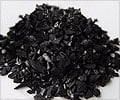carbon nanotubes to unite the virtues of plastics and metals in a new ultra-lightweight, conductive material that may revolutionize electromagnetic shielding .
University of Virginia engineering professor Mool C. Gupta and his team have used carbon nanotubes to unite the virtues of plastics and metals in a new ultra-lightweight, conductive material that may revolutionize electromagnetic shielding and more.
The team's innovation will be honored with a Nano50 award from Nanotech Briefs magazine, which “recognizes the top 50 technologies, products and innovators that have significantly impacted nanotechnology.”Sensitive electronic devices like cell phones and computers require shielding from electromagnetic interference (EMI). Such shielding — which must be electrically conductive — has traditionally been made of metal, which poses a weight problem in the push to miniaturize and lighten electronics.
In response, Gupta led a team that has developed an ultra-lightweight nanocomposite that outperforms conventional shielding.
This new nanocomposite material is a mixture of plastic, carbon nanotubes and a foaming agent, making it extremely lightweight, corrosion-proof and cheaper to produce than metal. The carbon nanotubes play a key role in creating these unique properties, explained Gupta. Most notably, experiments revealed that only 1 percent to 2 percent of the material’s composition needed to be comprised of nanotubes to increase the electrical conductivity by 10 orders of magnitude.
The addition of carbon nanotubes also increased the material’s thermal conductivity, improving its capacity to dissipate heat.
“Metal is not only heavy; it corrodes easily,” Gupta said. “And plastic insulators are lightweight, stable and cheaper to produce, but cannot conduct electricity. So the goal, originally, was to take plastic and make it electrically conductive.”
Advertisement
“The long length and small diameter of carbon nanotubes forms an interconnectivity within the plastic that makes it electrically conductive,” said Gupta, the Langley Professor of Electrical and Computer Engineering at U.Va.
Gupta’s team then added a foaming agent — a chemical that creates air pockets — to the material. The results astounded even the researchers; this extra step reduced the weight of the material by 50 percent and increased its flexibility.
Gupta's team included U.Va. postdoctoral fellow Dr. Y. Yang, and colleagues at the National Institute of Aerospace and the National Aeronautics and Space Administration. They will receive the Nano50 award in November 2007 at the NASA Tech Briefs National Nano Engineering Conference in Boston.
Source-Newswise
JAY/S






